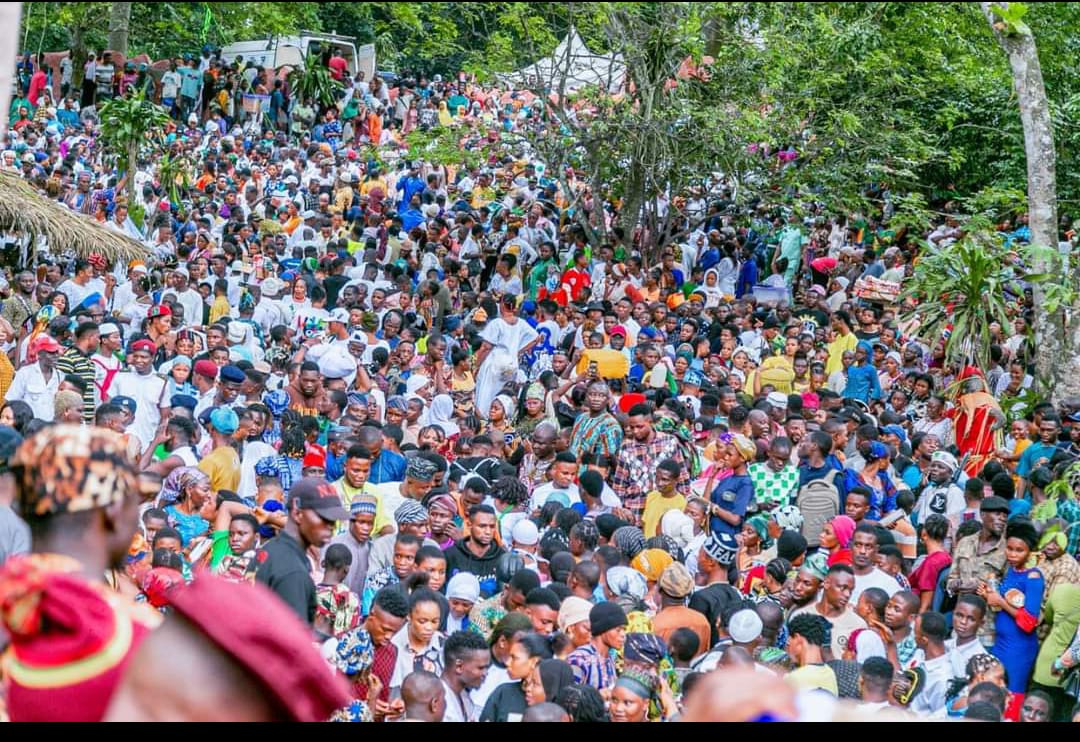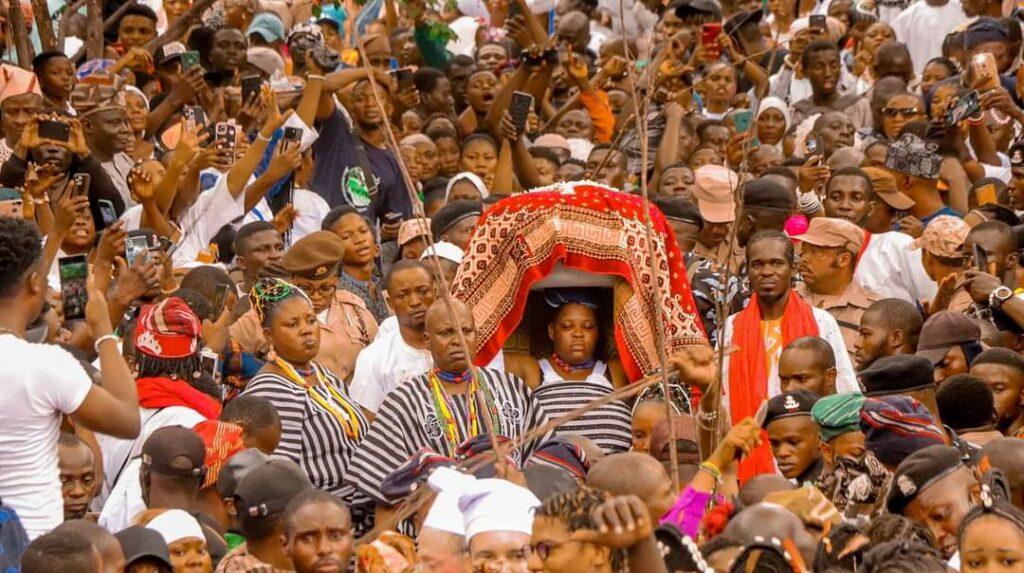The history of the Osun Osogbo festival dates back to the founding of the ancient town of Osogbo. When people from many continents come together to celebrate, they do it not only to venerate the River Goddess like other sacred rivers but also to resurrect a long-standing covenant between the River Osun Goddess, founders, and people of Osogbo.

There is historical consensus that Olutimehin, a famous hunter, led a group of people who were displaced by starvation and who eventually lived on the bank of the River Osun to protect themselves from famine. In order to prevent careless behaviors like pollution and others, the goddess commanded the hunter to lead his people off the riverbank and onto the main land.
She offered an annual sacrifice in exchange for which she would protect the group and bring them prosperity.
More than 700 years ago, according to some estimates, the Osun Osogbo festival began. It has encountered terrifying challenges that almost put the river’s devotees, its goal, and its significance in culture and tradition in danger.
HIGHLIGHTS OF THE OSUN OSOGBO FESTIVAL
The festival typically lasts two weeks and is observed every August. The event was made up of a number of activities, but its four main highlights are Iwopopo, the traditional cleansing of Osogbo, lightening of 16-face lamp) known as Ina Olojumerindinlogun, Iboriade, an assembly of the past kings’ crowns, the Osogbo Ataojas, for blessings, Arugba, the Virgin Calabash carrier procession, and Ikoesirodo.
IWOPOPO RITUAL – The traditional cleansing of Osogbo roads
Iwopopo, the customary town-cleansing ceremony, marks the festival’s opening. The Ataoja of Osogbo, his chiefs, and wives would travel on foot from the palace at Oja-Oba to Gbaemu crossroads, where the predecessors or ancestors offer prayers for guests’ safety as they travel to the town of Osogbo.
At the intersection, a tent would be used as a reception area for guests, where the king, his wife, chiefs, and other prominent citizens of the community would sit after the king might have inspected roads leading to the ancient town.
Every significant group in the community—from traditional societies to social organizations—would congregate at Gbaemu Junction during Iwopopo and bow before the king, wishing him and the rest of the royal family well while the king prayed for them.
The 500-year-old sixteen-point lamp ritual
Days after Iwopopo, the customary cleansing of the town, it appears that the lighting of the 500-year-old sixteen-point lamp known as Atupa Oloju merindinlogun is another significant event.
Osogbo natives received an antique lamp from their ancestors called Atupa Oloju merindinlogun.
The 16-face lamp was owned by forest spirits, according to research, who were seen dancing around it and working magic before Olutimehin, the great hunter who founded Osogbo, took it away from them.
The Osun shrines would be cleansed and renewed by using herbal leaves like ewe joogbo and ewe jaaba to wash every sacred object there. ‘Atupa oloju merindinlogun’, a 500-year-old six-point lamp, will be lit on the night of the purification of Osun shrines.
The 16-face lamp would be circled three times by the king. The king will do the first dance at precisely 7 o’clock in the evening. The king will do the second dance at precisely 10 p.m., and the third and final dance at precisely 5 a.m. the following day.
However, there are two kinds of drum that must be beaten during the lightning of 16-face lamp known as Atupa Oloju merindinlogun. They are namely; Aran Ifa drum and Agere Ogun Olutimehin. Ifa herbalists would beat Aran Ifa drums while Olutimehin descendants would beat Agere Ogun drums.
IBORIADE RITUAL – assemblage of past kings’ crowns
Before the Osun Osogbo festival’s great climax, one of the important rites must be performed. It will take place in one of the palace halls of Ataoja of Osogbo. During the ritual, the sitting Ataoja of Osogboland, the Arugba-Calabash bearer, the Yeye Osun, and a committee of priestesses gather all the crowns of the previous monarchs for blessings.
There is a specific day set aside for sacrifices to be made for the wives of previous Ataojas (Ojo Ayaba Isale) and for their homes or palaces (Ojo Ogboni). The monarch will also partake in a feast with his chiefs, family members, and the general populace during which he will also give alms to the needy and weak in the town.
PROCESSION OF ARUGBA – Calabash carrier girl
Most devotees and visitors consider the procession of Arugba, the calabash bearer girl, to the sacred groove to be the festival’s last ritual.
In this ritual, a sizable group of people, including the Ataoja of Osogbo, chiefs, and relatives would follow the Arugba, the girl who carried the calabash, to the sacred groove while drumming, dancing, and chanting of strong poetry for River Osun Goddess.
Before proceeding to the sacred groove to meet the River Osun Goddess, the Arugba, a calabash-carrying girl who would be closely escorted by Olose boys armed with sticks known as Whip boys, would branch out in the vicinity of four places. Arugba’s mother would let her hair down and begin praying for the Arugba’s easy return from the river in addition to places like Ile-Aworo where the Arugba would branch. There will be prayers at the shrine till the arrival of Arugba, the calabash bearer girl, an Osun priestess told WITHIN NIGERIA.
The large calabash would be dropped by the Arugba, a young woman of royal descent, at the river. The original agreement between the River Osun Goddess, Olutimehin—the great hunter—and the residents of Osogbo town was reaffirmed as the Ataoja of Osogbo, the Arugba—a virgin lady—and other significant officials sat in what is thought to be the first temple at the sacred groove.
IKOESIRODO
After the alleged big finale, which is the parade of Arugba, Ataoja of Osogbo, and followers to the sacred groove, the majority of worshippers go back to their various homes. Ikoesirodo, which literally translates as “the celebration of acceptance of sacrifice and prayers or going to the river with answered requests,” is typically performed a few days after the Arugba procession, during which the current Arugba—the person carrying the calabash—as well as previous Arugbas and priestesses, dance to a special groove in remembrance of the River Goddess and express gratitude for her care, provision, and acceptance of the yearly sacrifice.
Additionally, research showed that there are lesser Osun shrines like Osun Ajigun, Osun Lakookan that are as revered during the main celebration, and people would go to these shrines to worship the River Goddess if their sacrifices were offered to and accepted there.
SHORTCOMINGS OF OSUN OSOGBO FESTIVAL
Undoubtedly, the festival has flaws of its own that jeopardize its indescribable significance and soul. In addition to land speculators who pose a threat to the more than 700 acres of fertile, sacred land set aside as the River Goddess’ groove, there are other issues that are endangering the spirit of the area.
The celebration is more at risk from gold miners’ activities that have contaminated sacred water used for healing and deliverance. In addition to the debris-induced yellowish tint of the water, research has revealed that it also includes excessive levels of lead, arsenic, mercury, cyanide, and other dangerous substances that can result in neurological disorders or even death. Osun followers insist that the water is safe to drink and that River Goddess would protect the water body from contamination in spite of repeated warnings.
The festival is used as a setting for fights amongst hoodlums, a platform for rude touts to flaunt their fame, or a pretext for cult organizations to carry out reprisal attacks. These irate individuals rob or harm people every year at the festival. These touts are not visitors. They don’t come from neighboring towns to sabotage the festivities. They are a bunch of locals that have collectively harmed everyone and who received poor parental upbringing. They take their belongings, among other things, and prevent true devotees from peacefully adoring their Goddess.
The festival this year experienced cult attacks, like it had in years past. The festival claimed the lives of three young individuals. The goddess of the River Osun gives life and heals instead of taking it. She does not use blood and rather administers sacred water for healing. The police had pledged to look into the situation and detain any lawbreakers.
This is not the first time that festival goers have been murdered by touts or cultists. This is not the first time the police have vowed to arrest and prosecute offenders. In the historic town, there is no Junction where you won’t run across thugs.
Why haven’t the police detained these lawbreakers despite knowing who they are? It raises serious concerns about potential political sway or planned terror against visitors and devotees of Osun who come to worship their deity.
BENEFITS OF OSUN OSOGBO FESTIVAL
Those who oppose the celebration on the basis of their religious beliefs have not been effective in demonstrating that it is not “highly spiritual.” In addition to individuals who enter trance, hundreds of people also assert to have received children or answers to their prayers during the festival.
The annual celebration draws more than 5,000 visitors from around the world, including pilgrims, tourists, and researchers. They support local businesses including hotels, restaurants, and shops that sell traditional clothing and beads, among others, to help the local economy. There are private agents that serve as tour guides for visitors from other countries who come to worship the River Goddess and make millions of dollars once the festival is over.
The Osun-Osogbo festival also acts as a potent unifying force in Osogbo territory since it brings everyone together each year to celebrate the goddess, regardless of their various social, economic, religious, or political beliefs.
